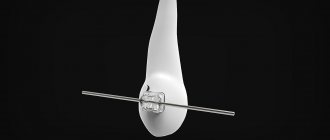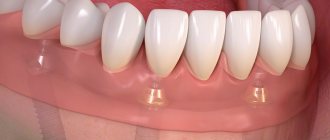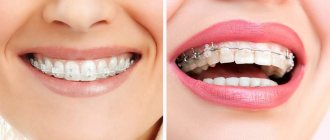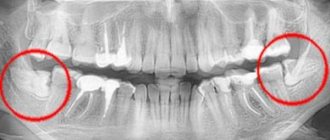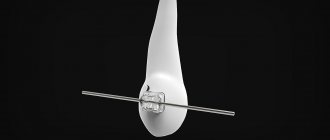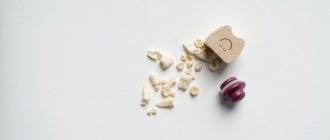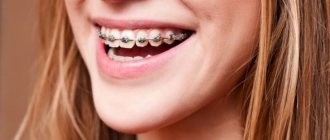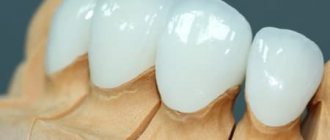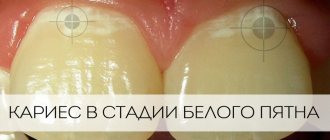To restore the dentition when there is a missing number of units in the dentition, prosthetics are performed using special orthopedic structures. They are made individually for each patient using impressions on which all the anatomical structures of the oral cavity are visible - the contour of the chewing units, palatal sutures, frenulum, etc.
In the article we will look at what dentures are made from impressions, what materials they are made from, how the impression is taken and how much dental prosthetics costs
(
price
in Moscow).
Is it possible to grow a tooth yourself?
Do human teeth grow? Yes, of course, they grow, because children no longer have “adult” teeth erupting. By this logic, it is quite possible to grow a tooth on yourself. But it was not there! Let's turn to the facts that the science of biology provides us.
In humans, tooth growth stops at 15-17 years of age. This process is genetically determined. Every person's teeth contain stem cells from which teeth could be re-grown. However, for reasons unknown to science, these cells “sleep”. Unlike sharks, camels, mice, beavers and other animals, whose teeth regenerate (grow) throughout their lives.
Only in 2021, biologists discovered the DLK1 protein in mice, which activates dental stem cells. Perhaps further study of it will answer the question: “Is it possible to regrow teeth?” So far, it is impossible to even “revive” a tooth again after removing the pulp (nerve), and science has not even begun to grow it again.
Price
The price of a print depends on the following factors:
- Features of the pathology. For example, in edentulous cases, individual dental trays are required to make impressions. This increases the cost of the procedure.
- Type of material. Typically, specialists do not use expensive raw materials when cheaper materials, for example, alginate, can be used.
On average, casting a plaster model will cost patients 300 rubles, and making an alginate impression costs the same. A silicone impression will cost more – from 550 rubles.
Myths about tooth extensions at home
Nevertheless, on the Internet there are “professional” tips on how to grow teeth at home. Something like this: eat chalk, ground animal bones and teeth into dust. It is also recommended to rinse your mouth with an alcohol tincture of propolis and calamus root, consume more milk and fish, and add crushed chicken egg shells to your food. If you apply this whole complex, then supposedly your teeth will grow slowly, but.
If this were true, potential dental clients around the world would have long ago exclaimed: “We grow teeth at home!” Propolis, fish and milk probably won’t make your body worse. Bone meal is included in the diet of farm and domestic animals as a source of calcium. It is also used as fertilizer.
Many scientists agree that eggshells can be eaten by people with a lack of calcium in the body. The shell of chicken eggs is 90% calcium carbonate.
We will not dispute or confirm the benefits of bone meal, eggshells, milk and propolis for teeth. However, they will not help in any way to grow a tooth at home, since they do not affect human genetics. We will not discuss the obviously ridiculous advice on how to regrow your teeth yourself with the power of thought. In humans, they basically cannot regenerate.
Classification
Products made from hardening mass perform many different functions. They differ in various characteristics, so there are several classifications used by dentists:
- by function - anatomical (allows measurements to be taken during physiological rest at the diagnostic stage or for the manufacture of individual structures, devices, devices) and functional (created on the basis of Herbst tests, in which the patient sucks in his cheeks, stretches out his lips, and the models obtained after this , allow you to track changes inside the oral apparatus in dynamics);
- by coverage area - complete (reflecting the entire dental arch with the palate) and partial (reflecting a small section of the dentofacial apparatus);
- by stages of implementation - single-phase (performed in one step) and two-phase (require re-application of the material on the first layer);
- according to the degree of pressure on the palate at the time of making the impression - compression (considerable pressure on the palate to compress and empty the vessels of the mucous membrane) and decompression (without pressure on the tissue of the prosthetic bed).
In recent years, another type has become widespread - digital impressions. This is a completely painless procedure that does not cause discomfort. The execution resembles the usual photography process. A small sensor with a camera on the end is used to read the outline of teeth and surrounding tissue. The data is displayed on the monitor, where it appears in the form of a 3-D model. The likelihood of even the smallest errors with this method is excluded. The only drawback of this method is the high price, since it requires the purchase of expensive equipment and professional software.
To grow a tooth or strengthen the enamel?
All advice on how to grow teeth at home only concerns strengthening tooth enamel. It is really possible to build up, or rather strengthen, tooth enamel at home. With age it becomes thinner; various metabolic disorders in the body, lack of calcium and fluoride make it loose, which is why the tooth is easily attacked by bacteria. To avoid problems, you need to take vitamin complexes, review your diet, and use special toothpastes and mouthwashes.
Under no circumstances should you prescribe all this to yourself. Be sure to consult your dentist! The clinic will offer you a remineralization procedure, the purpose of which is to strengthen the enamel. This will help keep your teeth healthy, but you won’t be able to build them up this way.
Types of impressions
Impressions are divided into anatomical and functional. In the first case, the construction is manufactured without taking into account the characteristics of the tissues that are located on the border of removable dentures.
In the process of creating functional structures, medical instruments are used, selected in accordance with the individual characteristics of the patient.
Due to this, the mobility of the soft tissue folds located on the border of the implantation bed is reflected on the impression. A functional impression is indicated for patients who have lost all or part of their teeth.
Functional type products are classified into types:
- Compression. Used to take an impression of the lower jaw.
The products reflect the relief of the base of the prosthesis and allow you to redistribute the load during chewing over a larger area of its base. Due to this property, premature atrophy of bone structures is prevented. To make a compression print, materials with high viscosity values are used. - Unloading. The base of the prosthesis made from the unloading cast will have the shape of uncompressed mucous membranes.
This type of device is recommended for people whose professional activities involve speaking. The load during chewing will be distributed unevenly due to the mismatch between the relief of the bone tissue and the base of the prosthesis. - Combined. Necessary for creating devices that compress the pliable and unload the sedentary areas of the mucous membranes of the mouth located in the prosthesis area.
Thanks to differentiated impressions, implants are created that provide an even load during chewing or speaking.
Is it possible to put a filling at home?
Anyone can experience an old filling falling out. In this case, the tooth is restored only in a dental office. True, there are thrifty craftsmen who post videos on the Internet about growing a tooth at home, or rather, about replacing a filling yourself. For this purpose, dental cement and food grade phosphoric acid are used.
However, in this way you also preserve the infection, which clearly developed under the old filling. Bacteria will continue to destroy the tooth from the inside. The only solution is to go to the dentist, where the remaining filling material will be removed, the cavity in the tooth and the root canals will be cleaned. And then the tooth will be filled again.
Similar advice is found for cases when a poorly installed crown falls out. “Experts” seriously discuss how to glue an extended tooth at home. The result of doing it on your own will be the same - an infection will develop under the crown glued at home, and within a couple of months the tooth will begin to decay.
Why is it necessary?
In dentistry, making impressions is necessary during various processes; it becomes a mandatory step when a person is faced with the need to use the following structures:
- Braces are systems necessary for the correction of various pathologies of occlusion and dental arches. Models are made both at the diagnostic stage for a detailed study of all anthropometric parameters of the patient, which are difficult to perform directly in the oral cavity, and for the manufacture of vestibular or lingual fixed braces.
- Retainers . To consolidate the results, after a course of wearing braces, a period of wearing retainers follows, which prevent the teeth from returning to their original position. Retainers are silicone mouth guards made to individual measurements.
- Trainers . Removable orthodontic structures that can be made individually. They are used to eliminate the causes and consequences of dental anomalies. To accurately impact facial aesthetics, detailed studies and accurate measurements of all parameters are required before installing trainers.
- Vestibular plates . To eliminate occlusion imperfections in children, plates are considered one of the most effective means, but this is only possible if all the anatomical characteristics transmitted to the structure through the casts match exactly.
- Removable dentures . In case of an inaccurate match, removable dentures cause a lot of discomfort and can irritate and rub soft tissues, so making the model is a very important step.
- Crowns . If an incisor, canine, premolar or molar is lost, models are made based on polyester mass.
- Bridges . Two manufacturing stages are needed: the first - during the creation of the frame, and the second - for the manufacture of the prosthesis body.
- Implantation . Before implanting the abutment, a model is first made from the impression mass.
Sometimes the manufacture of these products is necessary for home enamel whitening with an individual approach.
Reinforcement of partially lost teeth
As you already understand, the problem of how to regrow teeth cannot be solved at home; only a dentist can do this.
- Extension with composites. A tooth that is no more than half destroyed is restored with composite materials - light-curing fillings. The doctor applies the composite layer by layer, treating each of them with an ultraviolet lamp. Finally, the surface is sanded and polished.
- Extension with tabs. A more durable, high-quality and aesthetic alternative to composite fillings is ceramic inlays. They completely replicate the lost part of the tooth, and are manufactured using high-precision CAD/CAM equipment. Dental cement is used for installation.
- Extension with crowns. If the tooth is significantly damaged, it is depulped (the nerve is removed), ground down, and a crown is attached to it like a cap using dental cement. It can be made of metal ceramics, ceramics or zirconium dioxide. In cases where only the root remains of the tooth, it is possible to install a crown on a pin.
- Extension with veneers. If cracks, chips have formed on the surface of the front teeth, or simply their shape does not suit the patient, teeth can be augmented with thin (up to 1 millimeter) ceramic plates. They are glued to the outside of the teeth after pre-treatment. The result is a Hollywood smile with perfect teeth.
Materials
There are many more materials being used now than before. A hundred years ago, dentists had only hard materials in their arsenal, but at the moment they have been supplemented and continue to be supplemented with elastic ones.
Solid
Among solid materials, crystalline gypsum is most often used. It has become widespread due to the following advantages:
- availability;
- low cost;
- accurate display of all anatomical parameters.
But in comparison with more modern materials it has the following disadvantages:
- slight shrinkage after moisture evaporation;
- removal from the oral cavity in parts;
- the need to compare different parts, which increases the error;
- impossibility of use with high tooth mobility.
Because of these shortcomings, gypsum is used less and less in orthodontics and orthopedics, and in modern dentistry it has almost gone out of use.
Elastic
At the moment, this type of material is the most progressive, although it has its drawbacks. For example, there is a high risk of deformation after manufacturing. Most elastic materials change color during kneading, which makes it easier to control the preparation of the mixture and allows you to do it quickly and accurately. When choosing, take into account how accurate the display of the gingival parts is necessary.
Orthopedists and orthodontists have the following elastic materials in their arsenal:
- Silicone . There are two types of mixtures: A-silicone and C-silicone. They differ in the reactions of addition and condensation during the solidification of the masses. Silicone has no rival when it comes to accurately representing the tooth ledge and surrounding gum tissue. A-silicone does not require pre-drying of mucous tissues and enamel before application, but it is expensive. C-silicones are used to make one-piece complete structures.
- Alginates . The raw material is seaweed. Such compositions change color when liquid is added, which serves as an indicator of readiness when the desired thickness is reached. After taking the impression, you need to quickly cast the model, since alginates quickly deform.
- Polyesters . Expensive compositions that provide detailed reproduction of the relief of the mucous membrane and dentition.
- Thermoplastic . The condition changes due to exposure to temperature changes. As the temperature rises, softening and increased elasticity occur, and after cooling the product hardens. Thermoplastics are easy to use, provide a tight connection to the impression tray, but the main advantage is that they can be used many times.
- Modeling masses . May consist of paraffin, wax, stearin or mixtures of these substances. They are convenient, allow you to create high-precision impressions, but can become deformed under the influence of heat.
On sale, all these materials are found under different names, which are established by the manufacturer.
Removable dentures, manufacturing
An open smile puts you at ease, adds confidence and increases self-esteem. But poor environment, poor nutrition, oral diseases and hereditary factors can cause tooth decay or loss. Some people are intimidated by the idea of having false teeth and don't know how to wear or care for them. What to do if you encounter this problem? Specialists from the INTAN Implantation and Dentistry Centers will help restore your smile to its natural appearance by installing good removable dentures that do not affect your quality of life.
Contraindications
Before self-treatment, it is recommended to make sure that the source of pain is the tooth, and not the soft tissues of the oral cavity or neoplasms. The latter means:
- abscess;
- cysts;
- tumor formations;
- granulomas, etc.
If the dental nerve (pulp) is inflamed and there is intense pain, it is prohibited to close the hole with a filling. Absolute contraindications to the procedure are dental and systemic diseases.
Installation of filling material is allowed if there is mild pain and a deep cavity without darkening. The initial stages of caries are regarded as a contraindication, along with advanced carious processes. Otherwise, under a permanent filling, the disease develops faster, affecting dental tissue, dentin, and nerves.
If intense pain occurs, it is recommended to apply hygienic paste with fluoride to the chewing surface of the tooth before the procedure. Its composition has a calming effect and fills microcracks. It is prohibited to instill alcohol solutions into a carious cavity. The drug causes destruction of the nerve and soft tissues, provokes decomposition and necrosis.
If the hole is small, the filling must be placed by a doctor. It is impossible to fill the hole completely on your own. This allows food particles to become trapped and bacteria to grow in the open cavity.
Approaches to restoring the chewing surface
The approaches that will be discussed in this article are designed to greatly facilitate the work of doctors.
All the beauty that a specialist recreates ultimately turns into a shapeless, unaesthetic and low-functional “cake”. The dental literature describes a large number of various techniques to avoid such difficulties (compass method, orientation to adjacent teeth, occlusal compass, all kinds of schematizations, simplified construction algorithms, etc.). However, all these solutions provide only approximate results. The approaches that will be discussed in this article are designed to greatly facilitate the work of doctors and will allow the production of high-precision restorations. The main idea taken as the basis for this approach is that, depending on the degree of tooth decay, correspondingly different methodological variations of restoration are used. It should, however, be noted that these techniques are focused on working with vital teeth, that is, in conditions favorable for the formation of a strong adhesive connection. According to the degree of destruction, three conditional classes can be distinguished (the classification was developed by the author of the article).
Is it possible to glue a prosthesis with Moment glue?
Instant glue “Second”, “Moment”, “Super” and other trade names are available for sale. The point is not in the title, but in the content. This is cyanoacrylate. A substance that has excellent adhesion to most polymeric and inorganic substances. Its main advantage is its very fast setting.
It is ideally suited for gluing plastics. It would seem that there is no need to invent any special compositions - just apply a few drops of “Super Moment” and the prosthesis is ready for use again.
Not so simple. There are more negative points than positive ones:
- The glue contains a deadly cyanide base;
- “Super” glue is poorly resistant to aggressive environments and water. In them it quickly collapses. Microorganisms living in the oral cavity destroy the adhesive bond in 14-20 days. After this, the prosthesis will have to be repaired again.
- During the gluing process, a bead of dissolved acrylate is formed. In sensitive people, it can injure the palate and tongue.
- The glue is extremely fluid. It is difficult to accurately apply it to the edge of the fracture. Leaked glue dissolves the surface of the prosthesis and makes it rough. Because of this, the effect of suction to the palate is reduced. The prosthesis begins to wobble. Residues of food accumulate under it.
- It can only be used in an emergency situation, far from the centers of civilization. A prosthesis repaired in this way is not subject to warranty repair. And for restoration in a workshop you will have to pay at least double the price.
In conclusion, it remains to be stated that any dental workshop is a faithful and reliable friend in matters of repair and restoration of dentures.
Repair of dentures
What to do if an acrylic, clasp or nylon denture breaks? Contact your nearest dental clinic! Most dentists are equipped with dental laboratories and carry out urgent repairs of simple breakdowns in just 1-2 hours.
In addition, a large medical institution always has an orthopedic specialist on staff who will determine the cause of the breakdown, give recommendations to dentists and reposition the structure after it is repaired.
